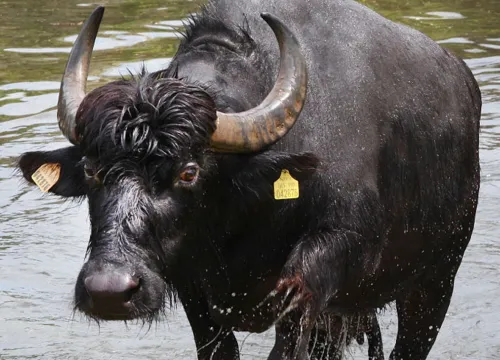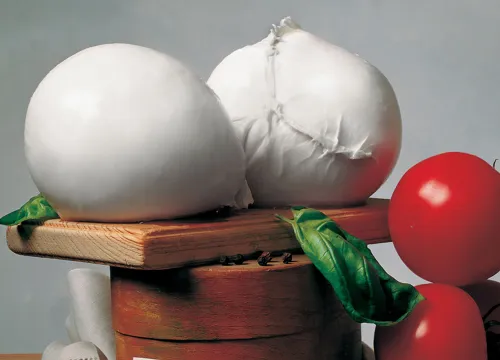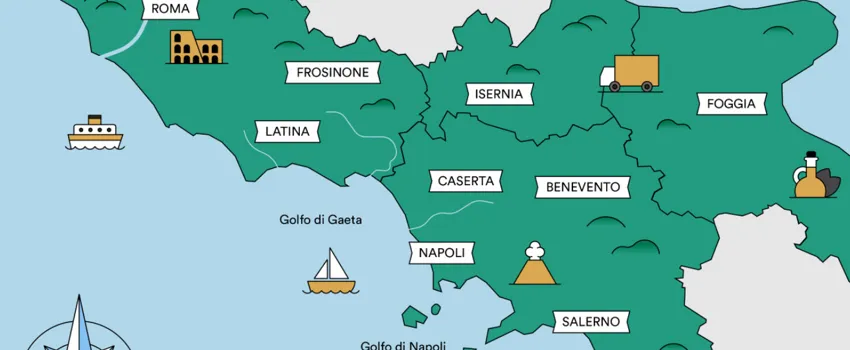Published:
Author: Antonio Maria Guerra
Buffalo Mozzarella

Buffalo Mozzarella is one of the most typical dairy products from the Italian region of Campania. Thanks to its unique taste this cheese earned the nickname ‘white gold’. With the precious help of its most traditional producers, let’s find out the origins of this specialty, in addition to a large number of information and interesting facts.

What is Buffalo Mozzarella?
Buffalo Mozzarella is a kind of cheese produced, as it’s easy to understand from the name, with buffalo milk: 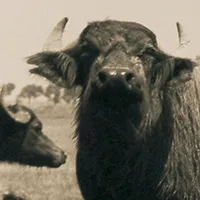 it’s quite different from ‘Fior di Latte’, another type of mozzarella which is made with cow’s milk instead. Originally from the Campania region (located in Southern Italy), this famous specialty belongs to the category of stretch-curd cheeses (formaggi a ‘pasta filata’), prepared by heating the curd which, this way, becomes elastic. This allows the cheesemaker to process it, adjusting the shape and size of the paste. Although it’s available in different shapes, the most classic Buffalo Mozzarella is round, boasting an inviting white color. To fully understand the value of this culinary masterpiece, it’s necessary to bite it: this causes a large quantity of milk to spill, generating an explosion of flavor in the mouth.
it’s quite different from ‘Fior di Latte’, another type of mozzarella which is made with cow’s milk instead. Originally from the Campania region (located in Southern Italy), this famous specialty belongs to the category of stretch-curd cheeses (formaggi a ‘pasta filata’), prepared by heating the curd which, this way, becomes elastic. This allows the cheesemaker to process it, adjusting the shape and size of the paste. Although it’s available in different shapes, the most classic Buffalo Mozzarella is round, boasting an inviting white color. To fully understand the value of this culinary masterpiece, it’s necessary to bite it: this causes a large quantity of milk to spill, generating an explosion of flavor in the mouth.
In this article we’ll show you the production method currently used for Buffalo Mozzarella. To read it, please click this LINK.

The history of Buffalo Mozzarella.
The origins of Buffalo Mozzarella are tied to a distant past: although there is no certainty, many scholars trace them back to the Middle Ages, a period in which the Arabs (followed by the Normans), would have introduced the breeding of buffaloes in southern Italy. The oldest documents where it’s possible to find an explicit reference to this specialty (*1) are from the XII century and consist in some notes in which the friars of the Monastery of San Lorenzo a Capua mention it using the names ‘Mozza’ and ‘Provatura’ (*2). The first ‘bufalare’ were built in the fifteenth century: brick buildings, dairies ante litteram, destined just to buffalo milk processing.
Read more
The earliest evidence of the use of the word ‘mozzarella’ dates back to 1570 and can be found in a cookbook written by the cook of Pope Pius V, Bartolomeo Scappi.
In the 18th century, the Bourbon royal family (*3) promoted the breeding of buffaloes in the province of Caserta: this decision greatly influenced the spreading and the success of the cheese, starting from the rich markets of the city of Naples and Salerno.
On June 12, 1996, the assignment of the prestigious Protected Origin Mark (D.O.P.) by Europe, marked the definitive consecration of the qualities of Mozzarella di Bufala Campana.
Notes:
*1: Or to a very similar specialty.
*2: The name ‘Provatura’ was used for the smoked type.
*3: Sovereigns of the Kingdom of the Two Sicilies.

Buffalo Mozzarella
THE MOST TRADITIONAL PRODUCERS
This article is the result of the collaboration between WebFoodCulture and the Consorzio di Tutela della Mozzarella di Bufala Campana PDO, organization gathering the most traditional producers of the famous dairy specialty.


Mozzarella di Bufala Campana PDO: the production areas.
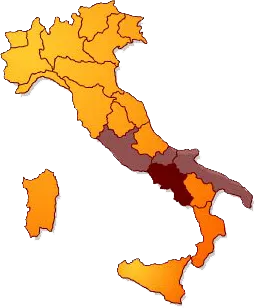 As indicated by the name itself, Mozzarella di Bufala Campana DOP is a dairy specialty typical from the Italian Region of Campania: not by chance, a great part of its production takes place in the provinces of:
As indicated by the name itself, Mozzarella di Bufala Campana DOP is a dairy specialty typical from the Italian Region of Campania: not by chance, a great part of its production takes place in the provinces of:
- Naples;
- Caserta;
- Salerno;
- Benevento;
The PDO policy document admits some exceptions, namely the provinces of Latina, Frosinone and Rome (in the region of Lazio), that of Venafro (in the region of Molise) and that of Foggia (in the region of Apulia).

The origins of the name ‘Mozzarella’.
The term ‘mozzarella’ derives from the Italian verb ‘mozzare’ (‘to tear‘), referring to the method used by the cheesemakers to cut the cheese dough into portions of various shapes and sizes.
Read more
Not surprisingly, the earliest written records about this specialty, dating back to the 12th century (*1), use for it the name ‘Mozza’.
The word, as we know it today, appeared for the first time in 1570, in a cookbook (*2) by Bartolomeo Scappi, who wrote:
The word, as we know it today, appeared for the first time in 1570, in a cookbook (*2) by Bartolomeo Scappi, who wrote:
“La Primauera, l’Estate, l’Autunno, di giuncate, capi di latte, butiro fresco, ricotte fiorite, mozzarelle fresche, et neue di latte”.
“During Spring, Summer and Autumn: cheese, milk, fresh butter, ricotta, fresh mozzarella and cottage cheese”.
Notes:
*1: These records consist of annotations written by the friars of the Monastery of Saint Lawrence in Capua;
*2: ‘Opera di M. Bartolomeo Scappi, Cvuoco secreto di Papa Pio V, divisa in sei libri’ by Bartolomeo Scappi, chef of the papal court;


The buffalos of Buffalo Mozzarella.
A great part of the incredible taste of Buffalo Mozzarella derives from the buffalo milk used in its preparation. The Italian/Mediterranean buffalo is a type of bovine that differs quite a lot (also genetically), from the other types of the same race: it has a massive build, with short and dark hair. Many scientists trace the beginning of its breeding back to the Middle Ages, others even to Roman times.
Read more
The milk of this animal is used to make not only Mozzarella but also many other dairy specialties, such as ‘Scamorza’, ‘Burrata’, ‘Ricotta’ and ‘Stracchino’.

Buffalo Mozzarella vs. ‘Fior di Latte’.
The main difference between Mozzarella di Bufala Campana PDO and ‘Fior di Latte’ (*1), lies in the type of milk used for the production of these cheeses. To prepare the first, as it’s easy to understand from the name, buffalo milk is used, while the other is made with cow’s milk. Although the manufacturing method for both dairy specialties is almost identical, the difference in the main ingredient affects:
Read more
- The taste: Buffalo Mozzarella is fatter and has a more intense flavor, characterized by a pleasant acidity.
- The color: Buffalo Mozzarella is generally whiter.
- The consistency: Buffalo Mozzarella is more elastic.
It should also be noted that, when cut, Buffalo Mozzarella releases a greater quantity of liquid (basically, milk) than the Fior di Latte.
Notes:
*1: ‘Fior di Latte’ cheese, simply known as ‘Mozzarella’, can boast the STG (Traditional Specialty Guaranteed) certification. As for the name, it should be noted that, especially in the Italian region of Campania, the term ‘Mozzarella’ is also used for Buffalo Mozzarella;

The right music for Buffalo Mozzarella.
The music by Roberto Murolo is probably the right choice to accompany the reading of this article:

Mozzarella: stretched curd cheese.
Stretch-curd cheeses (in Italian, ‘a pasta filata’), originating in southern Italy, are produced with a technique that involves heating the curd with boiling water: this makes it compact and elastic, therefore suitable to be worked by hand or with a specific machine. The processing consists of stretching the dough (an operation known as ‘filatura’, ‘spinning’), giving it different shapes. Stretch-curd cheeses can be fresh (like ‘mozzarella’), semi-hard (like ‘scamorza’) and hard (like ‘provoloni’ and ‘caciocavalli’). The procedure for the preparation of semi-hard and hard cheeses differs from that used for the fresh type, in that the curd is broken into smaller fragments and heated at higher temperatures.
Buffalo Mozzarella for Margherita Pizza.
Buffalo mozzarella is a key ingredient in the preparation of the queen of pizzas: the ‘Margherita’. In this regard, it’s important to remember that the world’s most-known Neapolitan specialty can also be made using ‘normal’ mozzarella (i.e., ‘Fior di Latte STG‘ made from cow’s milk).

‘Taverna’: the ancient market of Buffalo Mozzarella.
One of the first signs of the great commercial success of Buffalo Mozzarella was the birth of the ‘Taverna’: a real wholesale market, dedicated to this product and, more in general, to all the dairy specialties made with buffalo milk. The Taverna was founded immediately after the unification of Italy in the small town of Aversa, in the province of Caserta
Read more
In addition to being a large collecting and sorting center, it became the place where, like in a modern stock exchange, the price of this cheese was determined according to the demand.

Buffalo Mozzarella in the movies.
Buffalo Mozzarella is mentioned in many movies: one of the most famous examples is the Italian comedy film ‘Poverty and Nobility’ (‘Miseria e Nobiltà’), directed in 1954 by Mario Mattoli, in which one of the main characters invites Don Felice Sciosciammocca (played by Totò) to check the actual quality of Mozzarella by using this effective method:
Read more
“Ti fai dare mezzo chilo di mozzarella di Aversa, freschissima. Assicurati che sia buona: piglia queste dita, premi la mozzarella, se cola il latte, te la pigli, sennò … desisti!”.
“Get half a kilo of Mozzarella from Aversa and make sure it’s fresh: using your fingers, press it, if milk drips, you can buy it … otherwise, give up!”.

Consorzio di Tutela della Mozzarella di Bufala Campana DOP: contacts.
Address: Reggia di Caserta, Regie Cavallerizze
Via Gasparri, 1 – 81100 Caserta (Italy)
Official website: www.mozzarelladop.it
Mail: info@mozzarelladop.it
Tel.: +39 0823 424780
Copyright information.
The images displayed in this page belong to WebFoodCulture and to the Consorzio di Tutela della Mozzarella di Bufala Campana PDO, with the exception of:
Public Domain images
- Frame from the movie ‘Miseria e Nobiltà’, 1954 (Wikipedia Link)
Creative Commons images
- Roberto Murolo, 1955, image belonging to Augusto De Luca (Wikipedia Link)

